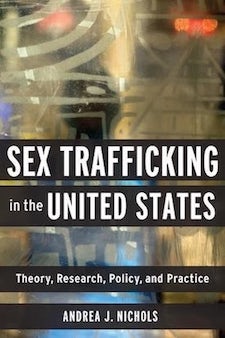SWJ Book Review – Sex Trafficking in the United States

SWJ Book Review – Sex Trafficking in the United States
Mae Key-Ketter

Andrea J. Nichols, Sex Trafficking in the United States: Theory, Research, Policy, and Practice. New York: Columbia University Press, 2016 [ISBN 9780231172639, Paperback, 336 pages]
Dr. Andrea J. Nichols is a professor of sociology at St. Louis Community College at Forest Park and lecturer and anti-trafficking initiative coordinator at Washington University in St. Louis. She is a Carnegie Award winning Professor and was awarded Feminist Criminology’s 2013 Best Article of the Year for her work in the sex trafficking/commercial sexual exploitation/sex work and intimate partner violence categories. Her later works include the co-edited Social Work Practice with Survivors of Sex Trafficking and Commercial Sexual Exploitation (Columbia University Press, 2018) and the co-authored Sex Trafficking and Commercial Sexual Exploitation: Prevention, Advocacy, and Trauma-Informed Practice (Springer, 2018).
Sex Trafficking in the United States, published six years ago, is Nichols’ foundational work and sets the stage for her later book efforts. In this work, she explores the dynamics of sex trafficking and provides an in-depth perspective from individuals that are involved in the industry and countering it. The book contains twelve chapters along with supporting notes, references, and an index. Following a logical and direct approach, Nichols breaks down her research within the book into the following three parts: Contemporary Debates of Theory, Research, and Policy; The Dynamics of Sex Trafficking in the United States; and Responses to Sex Trafficking. Within each part, a great amount of detailed information is provided to help readers who are foreign to the nature of this type of crime have a better understanding of the logistics and dynamics that factor into the world of sex trafficking. In Contemporary Debates of Theory, Research, and Policy, Nichols lays out the importance of how we define sex trafficking, common misconceptions of trafficking, the influence of market forces, and differing theoretical perspectives. Furthermore, the politics and debates solely focused on pornography and prostitution come to light and are analyzed.
In the section on the Dynamics of Sex Trafficking, which focuses within the United States, the three main types of actors that are involved in the operations—the exploited/survivors, traffickers, and buyers—are spotlighted. Understanding the description of each type of actor makes a significant difference when thinking about the questions revolving around prostitution which surface such as, “Who would want to be part of this market?”, “Why are girls not leaving the pimps right away?”, “How does technology factor into Sexual Exploitation?” or “What kind of person pays for sex?” At the end of book, Nichols shifts perspective towards focusing on the responses to sex trafficking. Most importantly, the involvement of the U.S Federal Government’s “The Trafficking Victims Protection Act” (TVPA 2000; and amendments) is discussed as is how individual state laws vary widely in both their definitions of sex trafficking and in their implementation. Moreover, the role of Social Services and Health Care responses towards individuals who are trafficked and the barriers those victims can face when it comes to accessing these services is highlighted.
Unlike a purely academically focused work, the book does not build off a hypothesis that Nichols is working from supported by a detailed research design and methodology. Instead, the book is at times more professionally focused, practical, and introductory in nature. It simply attempts to explain the theory and research behind, the dynamics of, and the responses to sex trafficking. Theoretically, Nichols accounts for all perspectives of sex trafficking varying from neoliberal, abolitionism, feminist, criminological, and sociological while keeping in mind the roles of race, ethnicity, immigrant status, and LGTBQ+ identities, age, sex, and intellectual disability that can further heighten the risks of individuals for this market. Furthermore, there are theoretical and real-world examples that are utilized to enhance a reader’s understanding of the dynamics of sex trafficking and the risks that it entails. The most identifiable commonality amongst all these factors is the intricacies involved due to the varying perspectives of trafficking resulting from the many misconceptions that are commonly held. The further an individual is in reading the work, the more he/she will realize the complexity of trafficking and that “getting rid of it” is a daunting task. Like other forms of illicit activity, this type of trafficking can be suppressed but not fully eliminated.
Nichols successfully fits an extensive amount of heavy information in less than 300 hundred pages which made reading it manageable. The book is well organized, thoughtfully researched, and comprehensible for those who are unfamiliar with the trafficking world. A strength of Nichols’s work is how she introduces her concepts and then follows through with detailed examples, displaying methodical planning of each section. Furthermore, she provides countless resources that are useful in relation to the subject itself. However, a downside is the extent to which Nichols proceeded to discuss these concepts and theories. Reading the work was at times tedious in the sense that she explained them in such detail that the language became jargon riddled.
Within Sex Trafficking in the United States, Nichols thoroughly blends very unpleasant information with readability, providing important lessons for those who are uneducated regarding sex trafficking. Because the victims are often so young, this often makes the subject matter a difficult read. In summation, this introductory book to the subject matter is very relevant for professionals in the fields of federal criminal justice and homeland security who may be tasked to focus on domestic sex trafficking activities. Additionally, police officers—specifically detectives and those assigned to specialized task forces, as well as some patrol personnel—should also consider investing in the book to educate themselves on how to proactively approach sex trafficking at a more localized level. Finally, anyone interested in this subject matter would also find the book a very useful resource.






